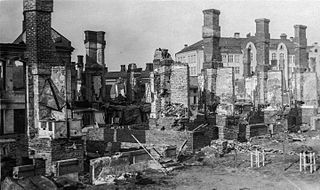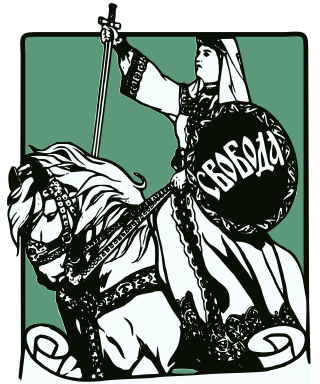
The Finnish Civil War was a civil war in Finland in 1918 fought for the leadership and control of the country between White Finland and the Finnish Socialist Workers' Republic during the country's transition from a grand duchy ruled by the Russian Empire to a fully independent state. The clashes took place in the context of the national, political, and social turmoil caused by World War I in Europe. The war was fought between the Red Guards, led by a section of the Social Democratic Party, and the White Guards, conducted by the senate and those who opposed socialism with assistance late in the war by the German Imperial Army at the request of the Finnish civil government. The paramilitary Red Guards, which were composed of industrial and agrarian workers, controlled the cities and industrial centres of southern Finland. The paramilitary White Guards, which consisted of land owners and those in the middle and upper classes, controlled rural central and northern Finland, and were led by General C. G. E. Mannerheim.

Juho Kusti Paasikivi was a Finnish politician who served as the seventh president of Finland from 1946 to 1956. Representing the Finnish Party until its dissolution in 1918 and then the National Coalition Party, he previously served as senator, member of parliament, envoy to Stockholm (1936–1939) and Moscow (1940–1941), and Prime Minister of Finland. He also held several other positions of trust, and was an influential figure in Finnish economics and politics for over fifty years.

Kaarlo Juho Ståhlberg was a Finnish jurist and academic who was one of the most important pioneers of republicanism in the country. He was the first president of Finland (1919–1925) and a liberal nationalist.

Pehr Evind Svinhufvud af Qvalstad was the third president of Finland from 1931 to 1937. Serving as a lawyer, judge, and politician in the Grand Duchy of Finland, which was at that time an autonomous state under the Russian Empire’s rule, Svinhufvud played a major role in the movement for Finnish independence. He was the one who presented the Declaration of Independence to the Parliament.
The Swedish People's Party of Finland is a Finnish political party founded in 1906. Its primary aim is to represent the interests of the minority Swedish-speaking population of Finland. The party is currently a participant in the Government of Petteri Orpo, holding the posts of Minister of Education, Minister for European Affairs, and Minister of Youth, Sport and Physical Activity.
The National Coalition Party is a liberal-conservative political party in Finland. It is currently the biggest party and the ruling political party of Finland.

The Centre Party, officially the Centre Party of Finland, is an agrarian-centrist political party in Finland. Ideologically, the Centre Party is positioned in the centre of the political spectrum. It has been described as liberal, social-liberal, liberal-conservative, and conservative-liberal. The party’s leader is Antti Kaikkonen, who was elected in June 2024 to succeed former minister Annika Saarikko. As of June 2023, the party has been part of the parliamentary opposition.

The Constitutional Democratic Party, also called Constitutional Democrats and formally the Party of People's Freedom, was a political party in the Russian Empire that promoted Western constitutional monarchy—among other policies—and attracted a base ranging from moderate conservatives to mild socialists. Party members were called Kadets from the abbreviation K-D of the party name. Konstantin Kavelin's and Boris Chicherin's writings formed the theoretical basis of the party's platform. Historian Pavel Miliukov was the party's leader throughout its existence.
The Finnish Party was a Fennoman conservative political party in the autonomous Grand Duchy of Finland and independent Finland. Born out of Finland's language strife in the 1860s, the party sought to improve the position of the Finnish language in Finnish society. Johan Vilhelm Snellman, Yrjö Sakari Yrjö-Koskinen, and Johan Richard Danielson-Kalmari were its ideological leaders. The party's chief organ was the Suometar newspaper, later Uusi Suometar, and its members were sometimes called Suometarians (suomettarelaiset).
The National Progressive Party was a liberal political party in Finland from 1918 to 1951. The party was founded 8 December 1918, after the Finnish Civil War, by the republican majority of the Young Finnish Party and the republican minority of the Finnish Party
This article gives an overview of liberalism and centrism in Finland. It is limited to liberal and centrist parties with substantial support, mainly proved by having had a representation in parliament. The sign ⇒ means a reference to another party in that scheme. For inclusion in this scheme it is not necessary so that parties labeled themselves as a liberal party.
This article gives an overview of liberalism and radicalism in Spain. It is limited to liberal and radical parties with substantial support, mainly proved by having been represented in parliament. The sign ⇒ denotes another party in that scheme. For inclusion in this scheme it is not necessary that parties label themselves as a liberal or radical party.

Finland declared its full independence on 6 December 1917. The formal Declaration of Independence was only part of the long process leading to the independence of Finland.

Santeri Alkio was a Finnish politician, author and journalist. He is also considered to be the ideological father of the Finnish Centre Party.

The Kingdom of Finland was a failed attempt to establish a monarchy in Finland in the aftermath of the Finnish Declaration of Independence from Russia in December 1917 and the Finnish Civil War from January to May 1918. The victorious Whites in the Parliament of Finland began the process of turning Finland into a kingdom and creating a monarchy. Although the country was legally a kingdom headed by a regent for over a year, the king-elect Friedrich Karl never reigned nor came to Finland following Germany's defeat in World War I. Republican victories in subsequent elections resulted in the country becoming a republic.
National liberalism is a variant of liberalism, combining liberal policies and issues with elements of nationalism. Historically, national liberalism has also been used in the same meaning as conservative liberalism (right-liberalism).

Young Finnish Agrarian League of the Southern Ostrobothnia was a party established on 21–22 October 1906 in Kauhava. It worked as an internal fraction of the Young Finnish Party or Constitutional-Fennoman Party. The strong man of the party was Santeri Alkio, who became elected as a member of the parliament of Finland on the list of Constitutional-Fennoman Party. He later formed his own parliamentary group of League of the Rural People of Finland. As it was obvious, that for the next elections both the Agrarian parties should be united, they formed Agrarian League in 1908. In parliamentary elections 1907 Young Finnish Agrarian League of the Southern Ostrobothnia had three candidates in the Vaasa southern electoral district, Vaasa eastern electoral district and Vaasa northern electoral district in electoral alliance with the Young Finnish Party. Santeri Alkio was elected and also two Young Finns' candidates. On 29 December 1907, the Young Finnish Agrarian League of the Southern Ostrobothnia agreed of merger with the League of the Rural People of Finland just for the elections

Two-stage presidential elections were held in Finland in 1931. On 15 and 16 January the public elected presidential electors to an electoral college. They in turn elected the President.The result was a victory for Pehr Evind Svinhufvud, who won on the third ballot by just two votes. The turnout for the popular vote was 47.3%.

The Revolutions of 1917–1923 were a revolutionary wave that included political unrest and armed revolts around the world inspired by the success of the Russian Revolution and the disorder created by the aftermath of World War I. The uprisings were mainly socialist or anti-colonial in nature. Some socialist revolts failed to create lasting socialist states. The revolutions had lasting effects in shaping the future European political landscape, with for example the collapse of the German Empire and the dissolution of Austria-Hungary.
This article deals with the political history of Finland from prehistoric times, through the Swedish rule (c.1200-1808), to the Russian rule and the time of independent Finland (1917-). In this context, Finland broadly refers to the geographical area in which the current Finnish state is located.










